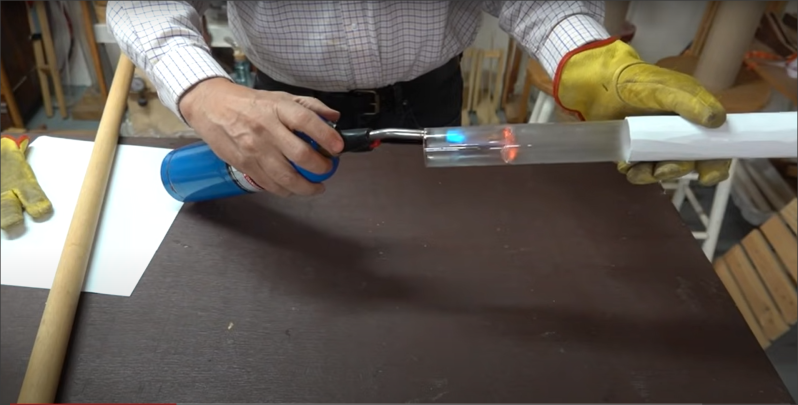The Rijke tube is a very simple device that demonstrates the principle of thermoacoustics quite clearly. Construction is quite straightforward, simply place a metal gauze at the bottom end of a tube, approximately one quarter of the way up, apply a source of heat to the gauze, and instant sound. The heat produces convection, setting up a longitudinal standing wave. This is due to air passing over the hot gauze, suddenly expanding and causing a pressure change, which rushes out the tube. Next, the airflow cools and slows, and air starts to head back into the tube, and the cycle repeats. Adjusting the tube length by slipping a sleeve over it, adjusts the pitch of the note, simply because the air has a different distance to travel. If there is a flame aimed at the gauze from below, the sound will stop since the air is already hot when it hits the hot gauze, no pressure change occurs, and no oscillation.
As [Keith], the reader who sent in the tip, suggests it would be fun to attach a servo to a sleeve on the tube, build multiple units and hang the whole thing off a MIDI controller. This could make for some fun times, and we have to agree. The problem of keeping the gauze hot could be solved in a number of ways, direct resistive heating could work, but maybe inductive heating would be cleaner?
Now, we can’t find an instrument which works in this manner, which sounds like a hack in the making for someone out there so inclined.
There have been a few fire-orientated musical devices over the years, such as this Rijke Tube Organ, various variants on the pyrophone, including this neat one performing with a tesla coil, and while we’re talking about music fire, howsabout a two dimensional rubens’ tube variant?
Thanks [Keith] for the tip!
















Make a musical instrument using a variety of pipe sizes and stoppers.
and then play “Rijke don’t lose that number”
You could call it a Toaster Organ!
How about you don’t, and just say you did. Tell them “you could have a change of heart.”
LOL!
I understod that as a half of a half, ie the length of the tube / 4.
It depends on how long your tube is. If you have a 100cm long tube, you need the grid 25cm from the bottom. If the tube is 50cm long, then the grid has to be 12.5cm from the bottom. And so forth.
Your list of “a few fire-orientated musical devices” should definitely include the Large Hot Pipe Organ (LHPO).
The original web site seems to have fallen prey to the must-have-https security theater, alas, but there seems to be a recording [1] around.
The idea is that you fill big (tuned) steel pipes with propane/air mix and ignite them, controlled by MIDI. Sounds like my idea of fun :)
[1] https://www.discogs.com/release/357315-Bastiaan-Maris-Large-Hot-Pipe-Organ
One quarter = 1/4
A quarter is a quarter, regardless of imperial or metric units. The length of the tube isn’t critical, only the location of the mesh.
The unit is “of the way up”, ie the length of the inside of the pipe. It is a relative measurement, so no absolute units would make sense.
3″ is one quarter of a foot just as 25 cm is one quarter or a metre, halves, quarters, etc and not metric or imperial, hell since monkeys can understand the concepts of half, quarter, etc it’s not even a specifically human concept, you should have learned this before you could walk. (But if you ever get a pie we can split in half, I’ll get the whole pie but you’ll never notice. :) )
For you metric people thats 25 centi-way-ups.
I also does not understand imperial units (it implies lots of conversions ;)
By the way if you listen to this wonderfull video, you’ll heard “centimeters” !
Around 6:50 he uses 3 different pipes, the yellow one is 48 cm long and sounds “G”, the red one is 67 cm long and sounds “E”. I heard that the smallest one (green) is 47 cm long (I must mistaken), and sounds “B”.
I had a hard working day, and came back sad to home … this video gave me a big smile … tomorrow I will surely try to do the same with some pipes I have laying around !
Imperial/ANSI likes rational arithmetic because it is exact. 10 is commensurate with 2 and 5. 12 is commensurate with 2, 3, 4, and 6, making 12 far superior for a measurement system with rational arithmetic.
60 is also nice with 2, 3, 4, 6, 10, 12, 15, 20, and 30.
The other fun aspect of the thermoacoustic effect is that it’s reversible. You can not only use heat to move sound but you can also use sound to move heat. You can make a thermoacoustic refrigerator.
Now if only I could figure out how to apply the math to the rf spectrum, to make an efficient electromagnetic version, the question is, what would it pump.
It’s a ratio and therefor does not have a specified unit. However the unit is clearly distance.
So the scientific standard would just be a ratio as a fraction (1/4), percentage (24%), or plain ratio (1:3).
OR if you wanted to use a SI it would be a distance of -6.020599913279622 dB of the total distance.
Seems to me such a tube would be ideally suited to be a warning device, say to alert someone that a pilot light has gone out.
Would make a great organ for the Kyteman Orchestra, since his music is mostly hot air anyway.
Found this ‘organ’ on YT https://youtu.be/qdII8sMYinY
That’s some nice tube sound, haha! Simple physics never stops to impress.
I wonder if placing a heating element rather than using fire would also create the effect.